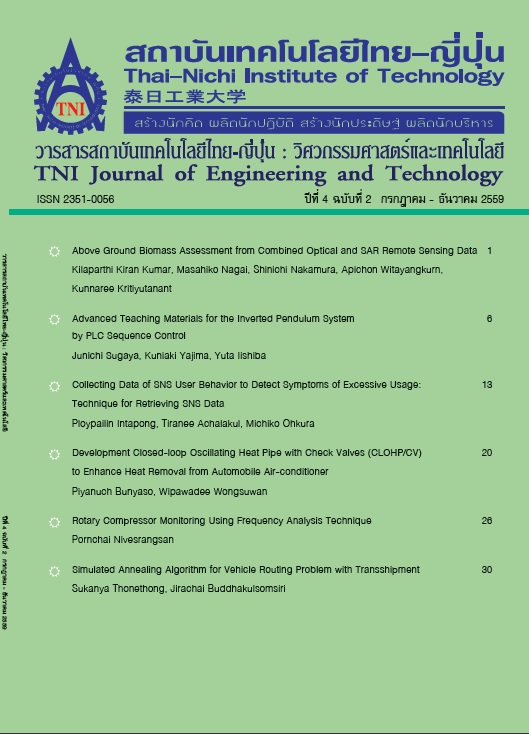Transportation Modes Detection in Bangkok Using GPS Logger data and GIS Data
Main Article Content
Abstract
Person trips and transportation mode surveys could be in multiple formats, such as telephone interviews and questionnaires. These data collecting methods rely on manual labeling of data after a survey, and thus, it requires more manpower, time and budget. However, the information technology has introduced advanced data collecting methods such as a mobile phone or a data logger device that can easily record travel time and location data of people. This information plays an essential role in transportation surveying. GPS data can be used to find many features involved in travelling, but those data need to be processed to find transportation modes used before further analysis. The main objective of this study is to detect transportation modes used in Bangkok using GPS logger data. Since the transportation modes in Bangkok are unique and various, there are many problems, such as traffic condition and complexity of the transportation network systems. Therefore, it is not very simple to determine transportation modes. GIS data is used to help detecting transportation modes that have specific routes and stations. Random Forest classifier is used for transportation modes detection. Modes considered in this study are walking, 2-wheel vehicles, 4-wheel vehicles, bus, skytrain, subway and boat. Moreover, activities of people in a week were focused on. Such activities include stationary and modes transferring points. The transportation modes could be automatically detected using our algorithms. This method can be applied for other person trip data collected from a mobile phone that can collect huge number of dataset, and the output data can be used for further analysis in transportation surveying and other related topics.
Article Details
Article Accepting Policy
The editorial board of Thai-Nichi Institute of Technology is pleased to receive articles from lecturers and experts in the fields of engineering and technology written in Thai or English. The academic work submitted for publication must not be published in any other publication before and must not be under consideration of other journal submissions. Therefore, those interested in participating in the dissemination of work and knowledge can submit their article to the editorial board for further submission to the screening committee to consider publishing in the journal. The articles that can be published include solely research articles. Interested persons can prepare their articles by reviewing recommendations for article authors.
Copyright infringement is solely the responsibility of the author(s) of the article. Articles that have been published must be screened and reviewed for quality from qualified experts approved by the editorial board.
The text that appears within each article published in this research journal is a personal opinion of each author, nothing related to Thai-Nichi Institute of Technology, and other faculty members in the institution in any way. Responsibilities and accuracy for the content of each article are owned by each author. If there is any mistake, each author will be responsible for his/her own article(s).
The editorial board reserves the right not to bring any content, views or comments of articles in the Journal of Thai-Nichi Institute of Technology to publish before receiving permission from the authorized author(s) in writing. The published work is the copyright of the Journal of Thai-Nichi Institute of Technology.
References
E.-H. Chung and A. Shalaby, “A Trip Reconstruction Tool for GPS-based Personal Travel Surveys,” Transportation Planning and Technology, vol. 28, no. 5, pp. 381–401, Oct. 2005.
E. D. Kaplan and C. Hegarty, Understanding GPS: Principles and Applications, 2nd ed. Norwood, Massachusetts: Artech House, 2006.
L. Liao, D. J. Patterson, D. Fox, and H. Kautz, “Learning and inferring transportation routines,”Artificial Intelligence, vol. 171, no. 5, pp. 311–331, Apr. 2007.
S. Reddy, M. Mun, J. Burke, D. Estrin, M. Hansen, and M. Srivastava, “Using Mobile Phones to Determine Transportation Modes,” ACM Trans. Sen. Netw., vol. 6, no. 2, pp. 13:1–13:27, Mar. 2010.
L. Stenneth, O. Wolfson, P. S. Yu, and B. Xu, “Transportation Mode Detection Using Mobile Phones and GIS Information,” in Proceedings of the 19th ACM SIGSPATIAL International Conference on Advances in Geographic Information Systems, New York, NY, USA, 2011, pp. 54–63.
“Transport Data and Model integrated with Multimodal Transport and Logistics,” The Office of Transportation and Traffic Policy and Planning, Ministration of Transport, 2011. [Online]. Available: https://www.otp.go.th.
E.-H. Chung and A. Shalaby, “A Trip Reconstruction Tool for GPS-based Personal Travel Surveys,” Transportation Planning and Technology, vol. 28, no. 5, pp. 381–401, Oct. 2005.
Y. Zheng, Y. Chen, Q. Li, X. Xie, and W.-Y. Ma, “Understanding transportation modes based on GPS data for Web applications,” ACM Transaction on the Web, vol. 4, Jan. 2010.
Y. Zheng, Q. Li, Y. Chen, X. Xie, and W.-Y. Ma, “Understanding mobility based on GPS data,” Microsoft Research, Sep. 2008.


